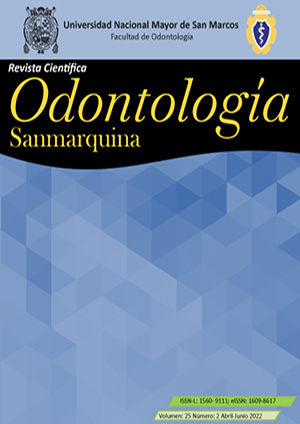Periodontal plastic surgery using connective tissue grafts in recessions
DOI:
https://doi.org/10.15381/os.v25i2.21610Keywords:
Surgical flaps, Gingival recession, Connective tissueAbstract
Periodontal plastic surgery is an alternative to cover root surfaces exposed by gingival recession. This technique restores aesthetics and maintains the fully functional dentition for the life of the patient. The aim of this review was to present, through a narrative review, the efficacy of periodontal surgery with the use of connective tissue grafts in the treatment of Miller class I and II gingival recession. Three hundred sixty-four articles were obtained from the PubMed database search between the years 2015 and 2022. After verifying compliance with the inclusion and exclusion criteria, 47 articles were fully analyzed. The use of a coronally displaced flap and connective tissue graft allows to achieve a high coverage efficiency of the exposed root surfaces, also showing an evident success with 95% total coverage of the root surface using a laterally displaced flap with connective tissue graft. The efficacy of root coverage in Miller class I and II gingival recessions was attributed to the use of connective tissue grafts combined with an adequate flap that allows the correct irrigation of the graft.
Downloads
Downloads
Published
Issue
Section
License
Copyright (c) 2022 Jonathan Andrés Panchi Lasluisa, Carlos Francisco Molina Gallegos, Carlos Andrés Molina Dávila, Ana del Carmen Armas Vega

This work is licensed under a Creative Commons Attribution 4.0 International License.
AUTHORS RETAIN THEIR RIGHTS:
a. Authors retain their trade mark rights and patent, and also on any process or procedure described in the article.
b. Authors retain their right to share, copy, distribute, perform and publicly communicate their article (eg, to place their article in an institutional repository or publish it in a book), with an acknowledgment of its initial publication in the Odontología Sanmarquina.
c. Authors retain theirs right to make a subsequent publication of their work, to use the article or any part thereof (eg a compilation of his papers, lecture notes, thesis, or a book), always indicating the source of publication (the originator of the work, journal, volume, number and date).






